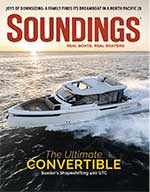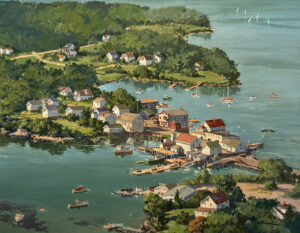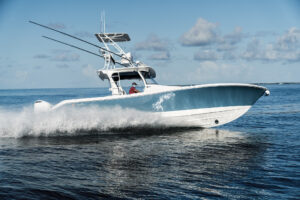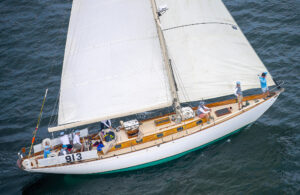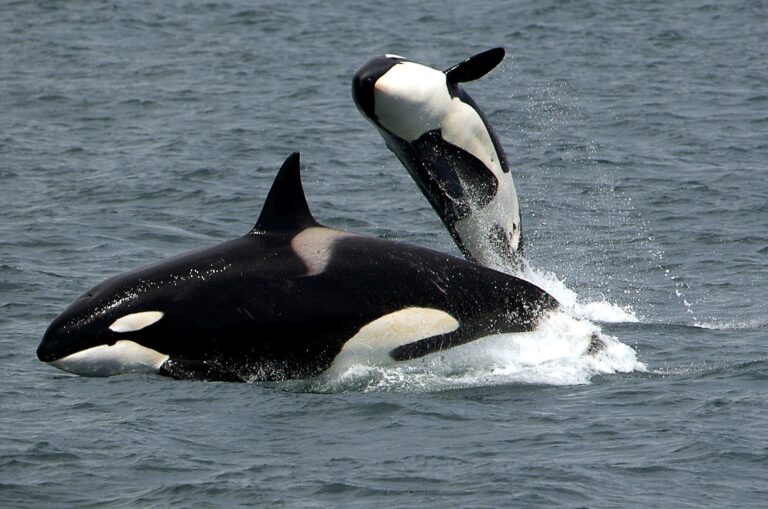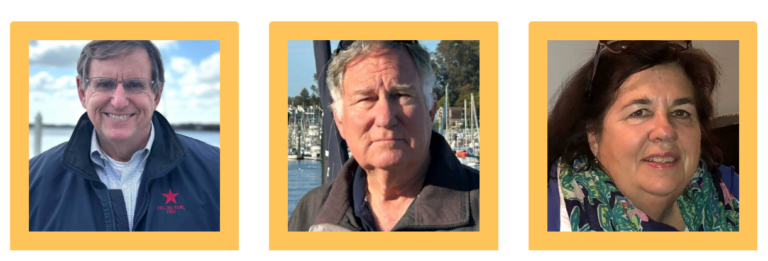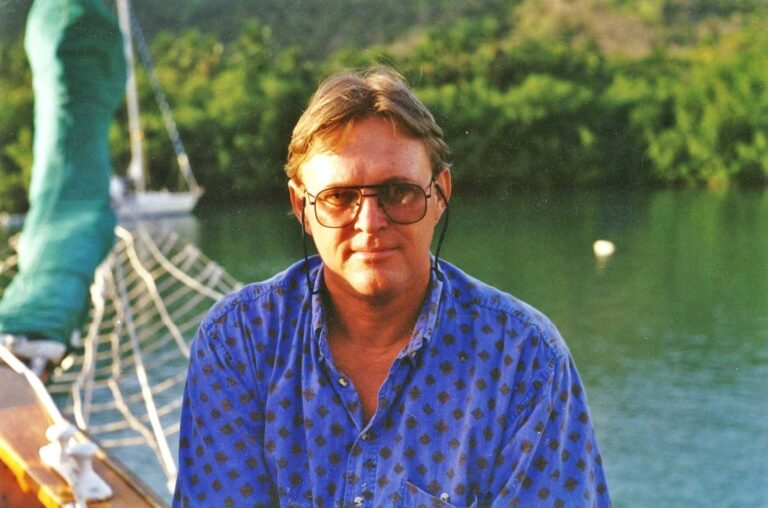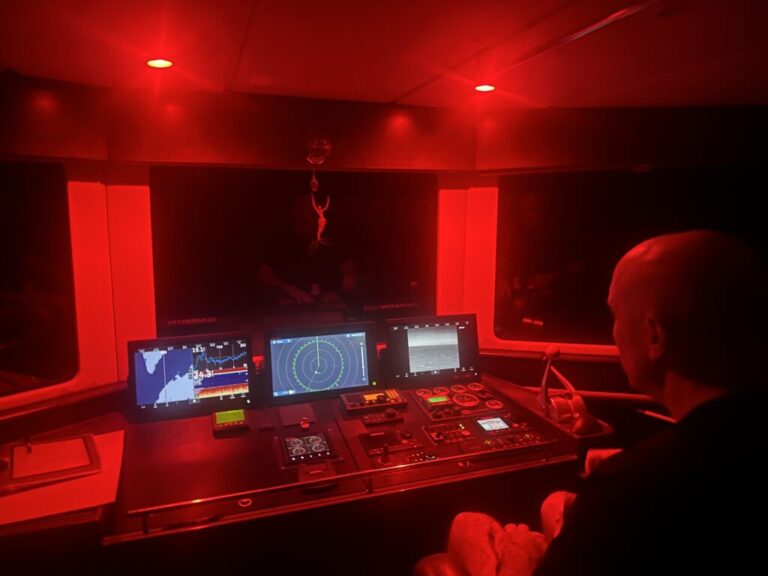
It’s pitch black. My hands, the saloon, the cockpit — everything reeks of diesel. The wind is howling outside, and we are being thrown around as Aretha, our 53-foot sailboat, slides off one wave into the next, whitewater crashing over the lifelines, filling the cockpit. We are drifting sideways.
Aretha is hove-to, slowed down in a sailing maneuver that lessens the boat’s motions while we figure things out. The sails are set one on each side of the boat, and the steering wheel is lashed down on one side. Nichola and I are physically exhausted. Every 20 minutes one of us wakes and wearily climbs up on deck to make sure no boats are bearing down on us.
We have experienced a power failure. We can’t start our generator or engine. And while Aretha is a sailboat, we nevertheless have no electronic navigation, no autopilot to steer the boat, no communications, no navigation lights, no lights down below (except our flashlights), no stove, no marine toilets, no way to pump water from our water tanks. We are, as they say, dead in the water.
Nichola and I are wearing our foul-weather gear, sleeping in the saloon instead of our bunks. Our three children are in our cabin at the stern, where there is less movement with the rise and fall of each wave and where they will get the most sleep.
The saloon, a space smaller than your average kitchen, looks like it has been ravaged by an intruder. The floorboards are up, tools and spare engine parts are everywhere, and Nichola and I are covered in grease and grime from wrestling with the engine. We still can’t determine the cause of our power failure.

We are in one of the remotest parts of the world, deep in the Pacific Ocean, more than 500 miles from the nearest piece of land, which itself is a tiny rock in the vast Pacific. There are no rescue services out here. We truly are on our own. There are three other boats within 100 miles, but there’s not much they can do to help. It’s pretty unfeasible for them to sail 100 miles and come alongside in 30-foot seas. We feel extremely isolated. We have to figure out the solution ourselves. It’s just the five of us: Nichola, my wife, age 43, our three young children — ages 9, 7 and 2 — and me, age 42.
How did our young family arrive mid-Pacific aboard Aretha, wave-tossed, without navigation instruments or power?
When we planned to sail around the world with our three children to create magical life-changing experiences, this wasn’t quite what we had in mind. We had imagined deserted tropical islands and snorkeling beautiful reefs. We had experienced all of that, true enough, and it was magical. What we would discover, though, is that the true “magic” happens on a much deeper level. We learned in our moments of adversity the power of working together as a team. Our toughest times became some of our most defining moments. We used the skills and tools I’ll share with you in these pages when the going got rough.

Magic happens when you decide to step beyond your comfort zone — when you challenge your beliefs, decide what you want and make it happen by following through with resolute determination. On that dark Pacific night, we worked together to solve a vexing problem that two years earlier would have frightened and panicked us. Instead we had settled the boat, settled ourselves and were working through the issues. We figured out how to survive and thrive in the face of adversity — a skill we all need for dealing with life. The seeds for how we survived were sown five years earlier. This power loss would eventually become one of our proudest experiences working together as a family team.

Along with challenging moments in mountainous seas and wild storms, our journey was filled with countless magical, shared experiences of the world: We explored and delighted in the Galapagos Islands, climbed the Mount Yasur volcano, swam with sharks in the Tuamoto Islands, brought humanitarian aid to a disaster zone in Vanuatu and were entranced by warm welcomes the world over.
Many people assume you need to be wealthy before you can live your dream. We did it the other way around. We made the decision to put our dream first and then created the wealth to make it happen. The reality is that to live your dreams — whatever they are — you need to make a committed decision, be extremely resourceful and then go make things happen.
Where the Magic Happens tells how the spark of an idea developed into a decision that created a full-blown, life-changing adventure that transformed our lives, our relationships and our fortunes. Nichola and I stepped out of our suburban commuter lifestyle, way beyond our comfort zones, undertaking something that challenged each of us, forcing us to grow in ways that we never imagined.

The Seeds Are Sown
Fifteen years prior to finding ourselves sea-tossed in the Pacific, back in 2000-2001, I’d been fortunate enough to sail around the world for my first time as part of the BT Global Challenge, known as the world’s toughest yacht race. As part of the selection process for the race, I was interviewed by its founder, Sir Chay Blyth, who said something that has stayed with me ever since:
“Caspar — there will come a day, a day when you are lying down looking at your toes. As you draw your final breath, you’ll ask yourself, Have I done everything I want to do in life? If the answer is no, you’re going to be pretty brassed off. So stop messing around, work out what you want to do and get on with it!”
It’s been my guiding force ever since.
This plan to sail around the world with our family was more than simply an adventure. Nichola and I had both had adventures before. Adventures are temporary. At some point with an adventure, you return to the life you had before. This was about lasting change.
There’s an abundance of advice on how to get more out of life — to live your dreams and to live before you die. Plenty of people would like to break out and live life to the full. Here are the three hurdles where many people get stuck: their partners, children and money. It can be uncertain and tricky to navigate these obstacles, to embrace a shared dream to make it happen. Yet it is all doable.

Our story is about creating major life changes together. Creating the family team. Creating the bonds. Creating relationships to last a lifetime. This is the story of the Craven family. It covers the sacrifices that Caspar, Nichola, Bluebell, Columbus and Willow made so we could transform our lives. It’s also about dealing with adversity and challenging conventional thinking.
We were nothing special. What Nichola and I did was make a committed joint decision (1), and we spent time truly understanding our purpose (2) and why that decision was so important to both of us. We created a plan that we pursued with relentless and unstoppable action (3). When one approach didn’t work, we were flexible and adapted our plans (4) until we finally achieved the reality that we had spent so much time imagining.
Those four elements enabled us to pull it off. However, we had to work it out as we went; there was no guidebook to help us. Our aim for Where the Magic Happens is to combine inspiration with practical guidance so you, too, can live your dreams.
Birth of an Idea
There are moments in life when everything changes. You’re not always aware of them at the time, but when you look back you realize you’ve experienced a transformational moment — life was never the same. I can remember only three or four such moments. Those are the big days — the instinctive decisions that you make in a heartbeat, without any real thought, because you just know. They just feel right.
It was June 13, 2009. Imagine a warm, early summer’s day in the garden of the leafy commuter village of Shipborne in Kent, southeast England. A buffet lunch on the patio, children running around playing, laughter and fun filling the air. We were living a typical family life in suburban London and celebrating my sister Pippa’s birthday. I was 37; Nichola was 38.
Our life was about to change. As we chatted over lunch in my sister’s garden that day, my brother-in-law, James, shared a story he’d read about a family who had decided to break from normal life and sail around the world. Nichola and I both shared an interest in traveling, and this topic, being different from the usual garden-party-type conversation, piqued Nichola’s interest, and she wanted to know more. The conversation ended with James concluding that the family was crazy, and so the topic was closed. Talk returned to the more usual conversational topics of work, kids and the week ahead. I thought no more about it. That afternoon, as we got back into our family car and reversed out of the drive, waving our goodbyes to head back to Surrey, something was different. Nichola turned to me and asked:
“Shall we do it?”
“Do what?” I said.
“Take a year out and go sailing with the children?”
One look at her, and I knew she was serious. I couldn’t hide my excitement — I needed no encouragement for an adventure. I was excited because I knew that if Nichola was on board as well, we were going to do this together.
The seed was planted. All it needed now was sunshine and water to grow. The most dangerous time for any idea is when it’s just been hatched; we all have so many ideas, and yet so few are ever acted upon. But we gently nurtured the idea over the months that followed.
Nichola’s initial thought was for us to take a year on a classics tour of the Mediterranean via sailboat. We’d done two flotilla sailing holidays there before we’d had children.
“What about the ARC?” I mused out loud. Nichola looked blank.
“The Atlantic Rally for Cruisers — where 200 to 300 yachts every year sail the Atlantic in convoy, crossing from the Canary Islands to St. Lucia in the Caribbean.”
“Oh. Well, that sounds safe enough,” said Nichola. “We’d be in the company of lots of other yachts.”
I pressed on. “And once we’ve sailed the Atlantic, why not keep going — through the Panama Canal, across the Pacific to Australia and then back via the Indian Ocean and up the Atlantic again?”
And so the idea developed.

4 Elements for Family Life Change
- Committed joint decision — dream together and create a shared picture and story around the future.
- Understand your purpose — why your decision is a “must have” rather than a “nice to have.”
- Make a plan together and get into relentless action to bring that plan to life.
- Be flexible and keep adapting your approach until you achieve the future you imagined.
From Where the Magic Happens: How a Young Family Changed Their Lives and Sailed Around the World, by Caspar Craven. Copyright © Caspar Craven, 2018. Published by Adlard Coles, an imprint of Bloomsbury Publishing. Reprinted with permission.
This article originally appeared in the April 2018 issue.

